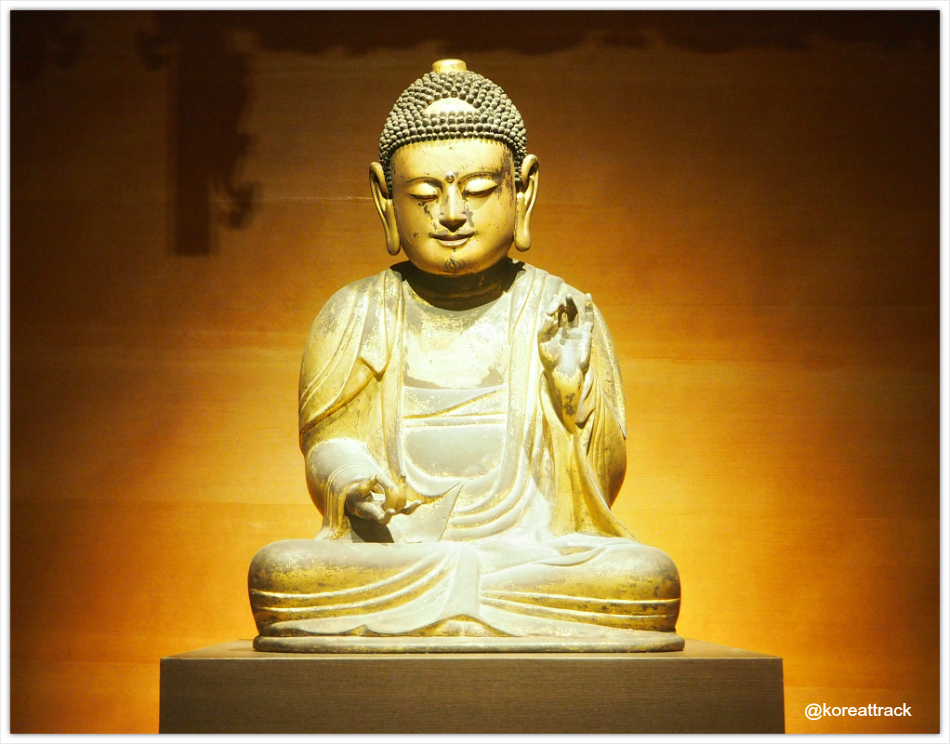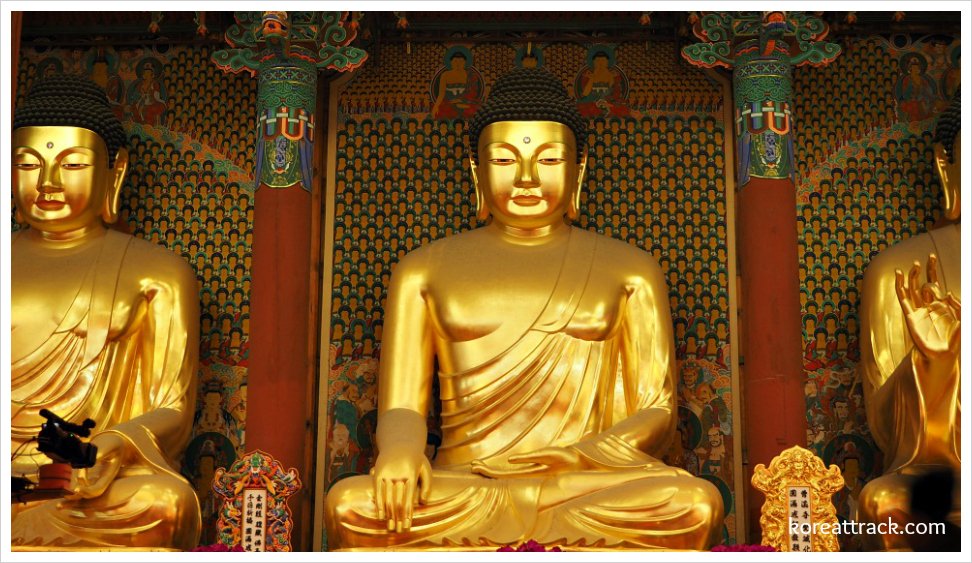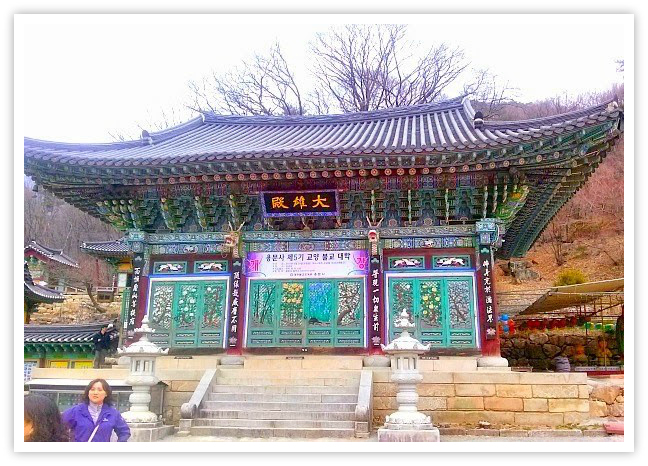Songgwangsa Temple in
Jogyesan Mountain
 The main Dharma Hall (Daeungjeon) at Songgwangsa Temple in Jogyesan Mountain
The main Dharma Hall (Daeungjeon) at Songgwangsa Temple in Jogyesan MountainSonggwangsa Temple in Jogyesan
Nestled in the picturesque mountains of South Korea, Songgwangsa Temple (Korean: 송광사; Hanja: 松廣寺), also known as the Flower Garland Temple, is a significant cultural and religious landmark in Korean Buddhist history.
With its stunning architecture, serene atmosphere, and rich heritage, the temple is a popular destination for locals and tourists seeking spiritual enlightenment and a deeper understanding of Korean Buddhism.
Founding & Origins

Songgwangsa Temple in Jogyesan is one of the most prominent Buddhist temples in South Korea and has a rich history that dates back to 544 CE. According to historical records, Venerable Yeongi Josa, a renowned Buddhist monk during the Silla Dynasty, founded the temple.
The original name of the temple was Gilsangsa, but it was later renamed Songgwangsa, which means "a temple in which 18 great monks will spread the teaching of Buddha."
The name Songgwang derives from the 18 great monks, regarded as the most venerated individuals in the Buddhist tradition. The term "Gwang" signifies the propagation of Buddhism, which is the primary goal of the temple.
Songgwangsa is a place of worship and a center for Buddhist education and research.
The temple is located on Mount Jogye in South Jeolla Province, known for its scenic beauty and tranquil environment. The natural surroundings of the temple offer a peaceful and secluded atmosphere, ideal for meditation and spiritual practice.
The temple complex consists of various halls, including the Main Buddha Hall, the Dharma Hall, and the Meditation Hall, each with unique architecture and significance. Visitors can explore the temple grounds and learn about the history and teachings of Buddhism.
Seon Tradition & Jinul's Influence

During the Goryeo Dynasty, which lasted from 918 to 1392, Songgwangsa temple played a crucial role in developing and spreading Seon (Zen) Buddhism in Korea.
The temple was originally built during the Silla Era (57 BC—935 AD), but it became one of the leading centers of Seon practice during the Goryeo Dynasty.
The renowned Seon master, Venerable Jinul (Chinul or Bojo Guksa) significantly re-established the temple in 1190 and revitalized the Seon tradition.
Jinul was a prolific writer and practitioner who emphasized the importance of integrating study and practice and attaining sudden enlightenment (satori).
Jinul's meditation teachings were deeply influenced by his experiences at Songgwangsa, and he used this knowledge to shape the Seon practice that prevails in Korea today significantly.
His emphasis on the importance of sudden enlightenment and the integration of study and practice left an indelible mark on Korean Buddhism and has contributed to the continued popularity of the Seon tradition in Korea.
 A stream within Songgwansa Temple in Jogyesan
A stream within Songgwansa Temple in JogyesanCultural Treasures
Nestled within the temple complex is the awe-inspiring Gakhwangjeon Hall, an architectural wonder that has stood the test of time.
Its magnificent structure is a sight to behold, drawing visitors from far and wide. Standing tall and proud in front of the hall is the giant Stone Lantern, a priceless treasure from the United Silla era.
With a towering height of 6.4 meters (21 feet) and a width of 2.8 meters (9 feet), the ancient lantern is hard to miss. It symbolizes wisdom and enlightenment, a beacon of hope that has endured time.
The intricate details and timeless craftsmanship of this National Treasure No. 12 is a testament to the region's rich cultural heritage.
Natural Beauty and Spiritual Retreat
In the Jogyesan Provincial Park, Songgwangsa is a serene Buddhist temple surrounded by lush forests and valleys.
Situated approximately 18 miles (29 km) from the sea, the temple's peaceful surroundings offer a perfect retreat for those seeking to connect with nature and experience a sense of calm.
With a rich history and cultural significance, Songgwangsa remains a popular destination for those who desire to explore the teachings of Buddhism, indulge in meditation, and embark on a spiritual pilgrimage.
Recent Features and Preservation Efforts
Songgwangsa, a magnificent temple located in the serene mountains of South Korea, has witnessed many historical events.
Though it suffered damage during the Korean War, the temple's spiritual and cultural significance has been preserved through years of restoration efforts.
Today, Songgwangsa remains a popular destination for devotees, scholars, and tourists alike, all eager to explore its ancient halls, pagodas, and sacred grounds.
One of the temple's most celebrated features is the mesmerizing fall foliage that blankets the surrounding mountains in vibrant orange, red, and yellow hues.
People from all over the world come to witness this natural spectacle, which is said to be one of the most breathtaking sights in the region.
With its rich history, stunning architecture, and stunning natural beauty, Songgwangsa is truly a gem of South Korea and a must-visit destination for anyone seeking peace and tranquility.
Songgwangsa Temple is a testament to Korea's enduring Buddhist heritage, where ancient wisdom meets natural beauty. 🌸🏯🙏.
Getting to Songgwangsa Temple
Songgwangsa Temple (Korean: 송광사) is a significant Seon Buddhist temple on Mount Jogye in South Jeolla Province, South Korea. It's considered one of the three jewels of Korean Buddhism, along with Tongdo-sa and Haein-sa. Here's how you can get there from Seoul:
By Train
- Take a train from Seoul Station to Suncheon Station (approximately 3 hours).
- From Suncheon Station, you can take a taxi or a local bus to Songgwangsa Temple (about 1 hour).
By Bus
- Take an express bus from Seoul Express Bus Terminal to Suncheon Express Bus Terminal (around 4-5 hours).
- From Suncheon Bus Terminal, you can take a taxi or a local bus to the temple.
By Car
- Drive from Seoul to Songgwangsa Temple (approximately 4-5 hours, depending on traffic).
- Use a navigation app or follow signs for Jogyesan Provincial Park.
Once you arrive at the temple, you'll be surrounded by serene nature and have the opportunity to explore this historic and spiritually significant site. Enjoy your visit! 🌿🙏
For more details, you can visit the official website of Songgwangsa Temple. If you're interested in hiking, the temple is in the beautiful Jogyesan Provincial Park in Jeollanam-do.
Sources:
- https://bing.com/search?q=Songgwangsa+Temple+history
- https://www.songgwangsa.org/
- https://en.wikipedia.org/wiki/Songgwangsa
- https://www.alltrails.com/trail/south-korea/jeollanam-do/songgwangsa-temple-yeonsanbong-loop
- Home
- Temples in South Korea
- Songgwangsa Temple In Jogyesan
Get Exciting Activities
Book one of our exciting activities today to experience the thrill of a lifetime! Take advantage of this opportunity and secure your spot in advance.
Hotel Map Guide
Find your affordable, accessible, and comfortable hotel in Seoul at Agoda.Com. See the hotel map below...
Hotel Booking Guide
Find affordable and amazing hotels on Agoda.com using the search box below. Book now to enjoy great discounts and save!







New! Comments
What do you think about this page? Leave me a comment in the box below.